An Insight into Ionic Conductivity of Polyaniline Thin Films
Abstract
1. Introduction
2. Materials and Methods
3. Results
3.1. Cyclic Voltammetry of the Polyaniline Film
3.2. Study of the Aniline Electrochemical Polymarization by Electrochemical Quartz Crystal Microgravimetry(EQCM)
3.3. Characterization of the Polyaniline Film by Impedance Spectroscopy
4. Theoretical Part
- The initial approximate values of diffusion coefficients for cations (D+) and anions (D−) are proposed, e.g., 1·× 10−10 m2·s−1. The values will be further adjusted during iteration steps.
- The thickness of the polymer film is divided by n equal fragments (d = l/n), n equals number of frequency.
- The matrix of γ-coefficients Γnn is created. Each element is calculated by the Equation (5), which is formed from Equation (2) to estimate the average value of γ in the considered distance interval [x1; x2] (see Equation S56 for details).
- Two systems of equations have to be solved to estimate values of resistances and capacitances of each elementary layer (R(xi) and C(xi)). The system of equation concerned with resistances is shown below in a matrix form.The resistance estimated at a given frequency ωi comprises resistances of k film fragments. Due to different γ-coefficients impact of the close fragments to the total resistance is larger than that of the remote fragments:or written in a full matrix form in Equation (7)The R(xj)—matrix sought could be calculated using inverse matrix approach (in case of equality of number of frequency points and fragments) or by linear function analysis.The same approach is applied to estimate values of capacitances.
- Having the values of capacitances, resistances and diffusion coefficients at one’s disposal means one can estimate the values of concentration in all the considered fragments.
5. Discussion
5.1. Cyclic Voltammetry
5.2. EQCM Study
5.3. Electrochemical Impedance Spectroscopy (EIS)Study
5.4. Analysis of Impedance Spectra
6. Conclusions
Supplementary Materials
Author Contributions
Funding
Acknowledgments
Conflicts of Interest
Appendix A
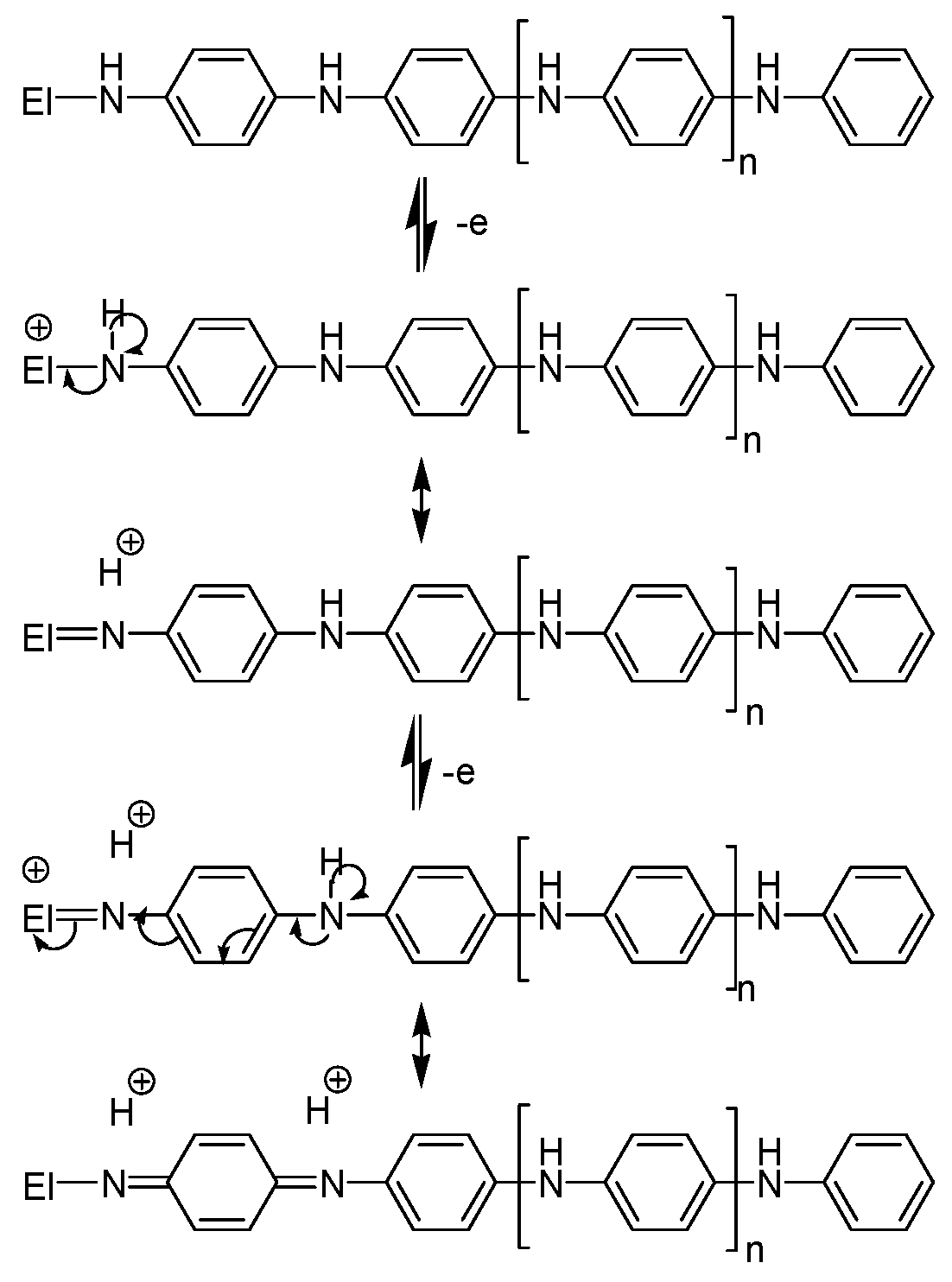
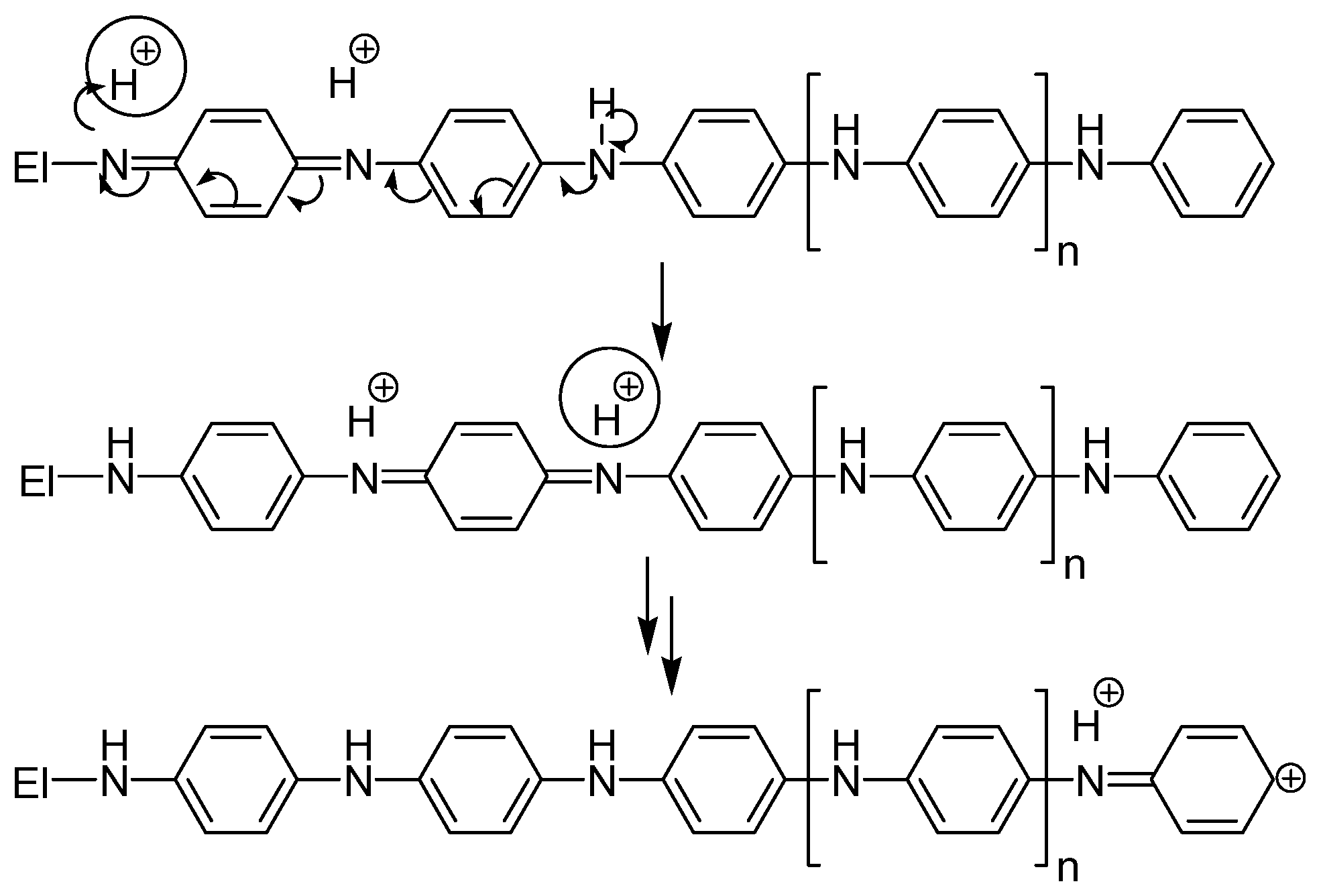
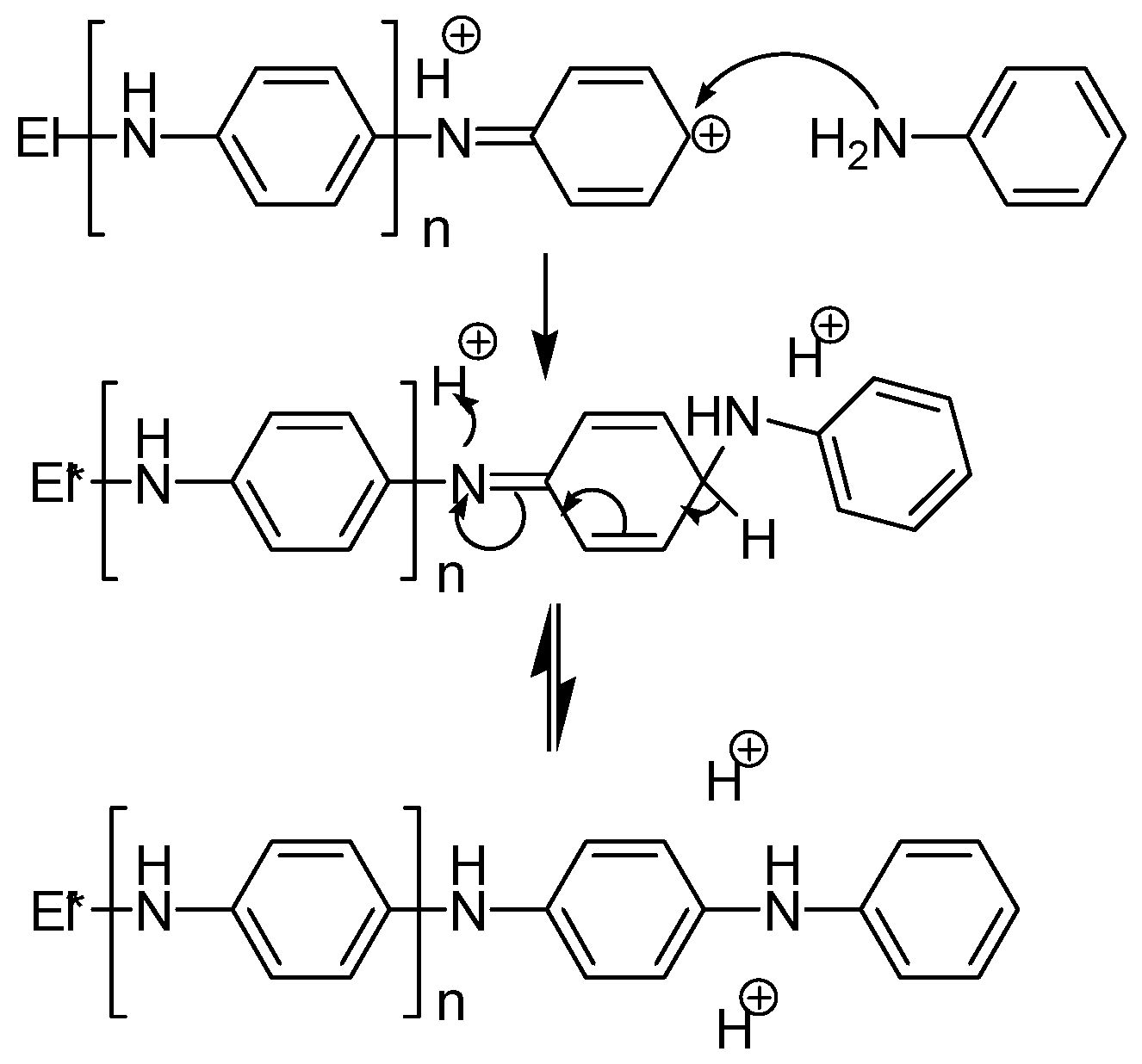
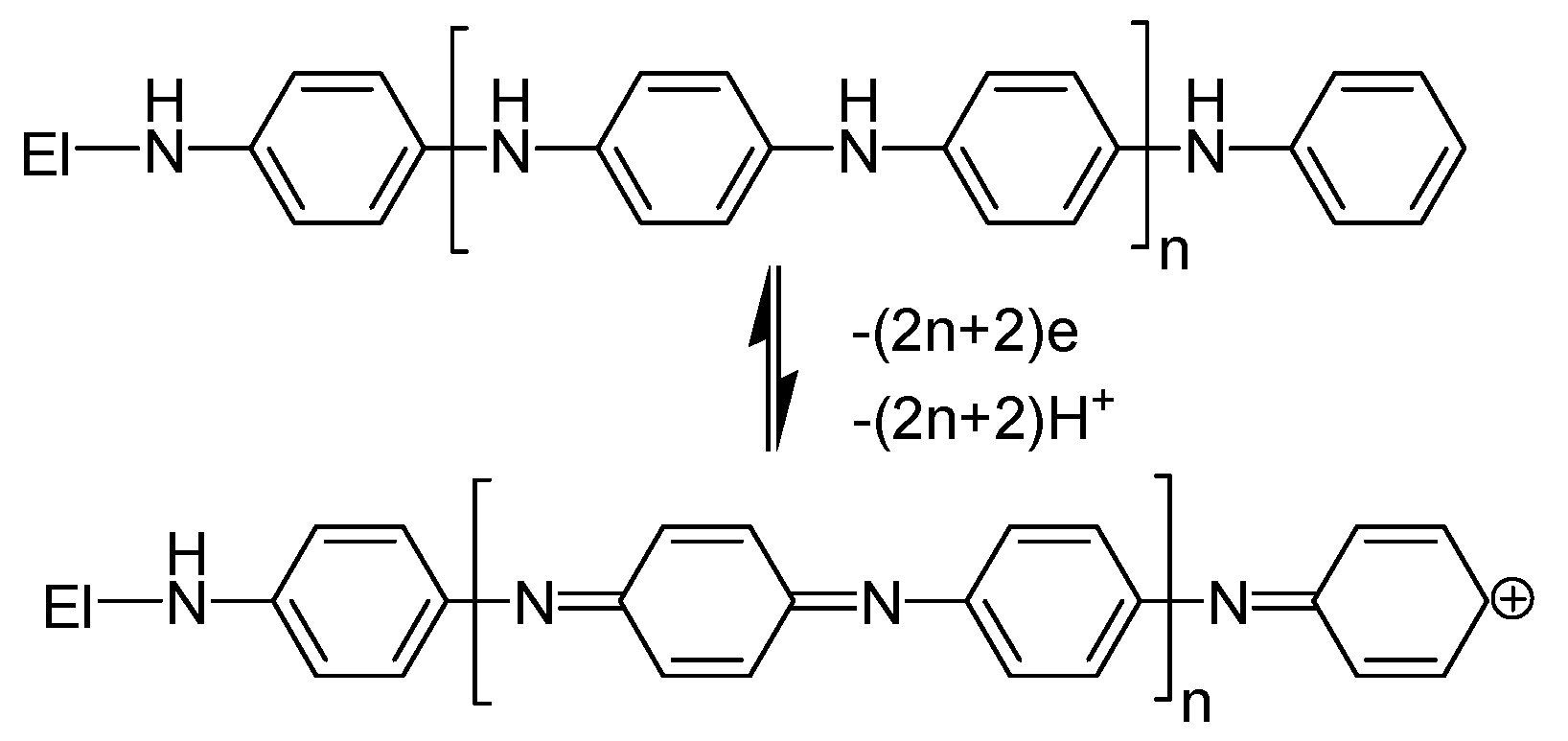
Appendix B
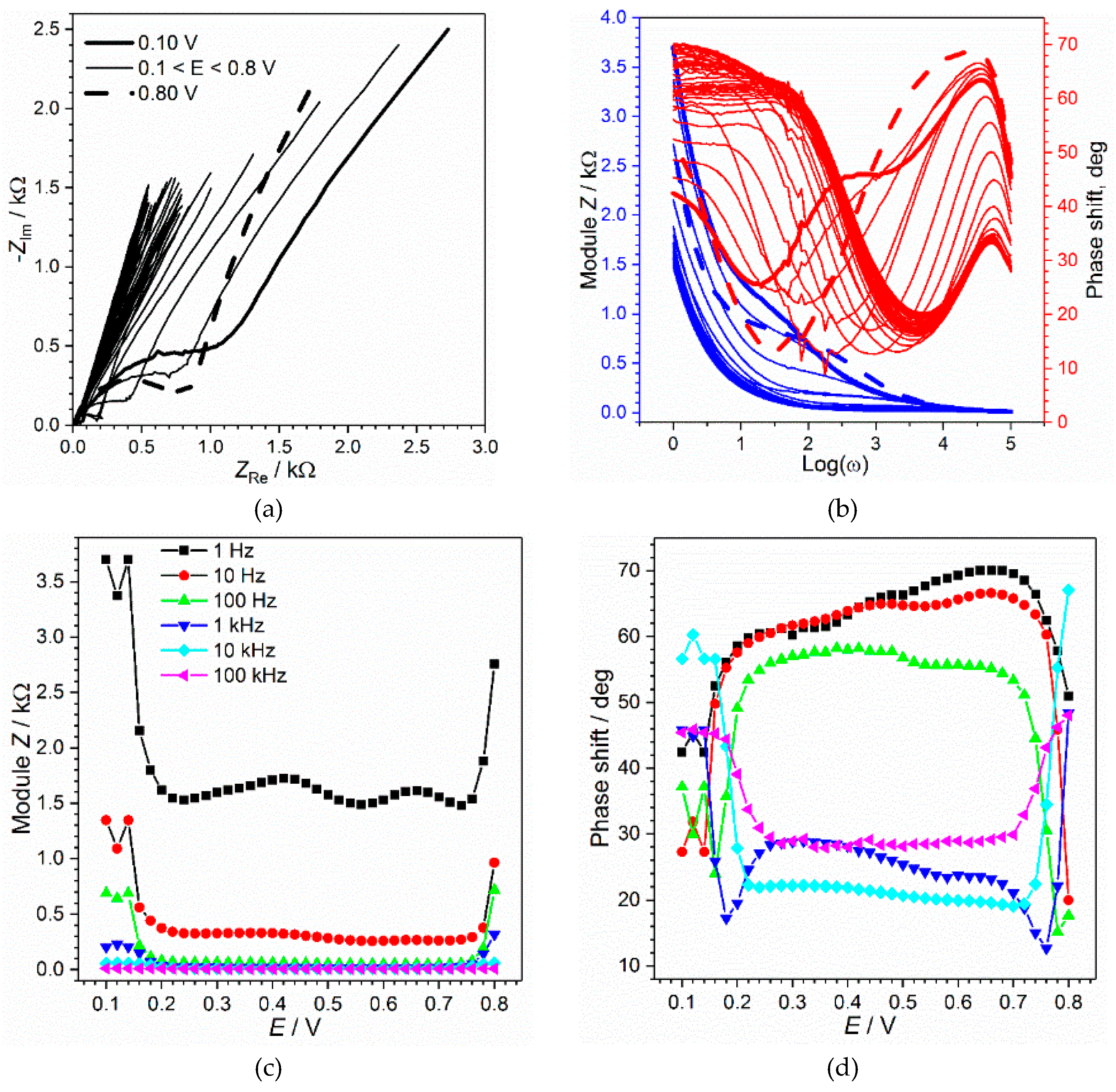
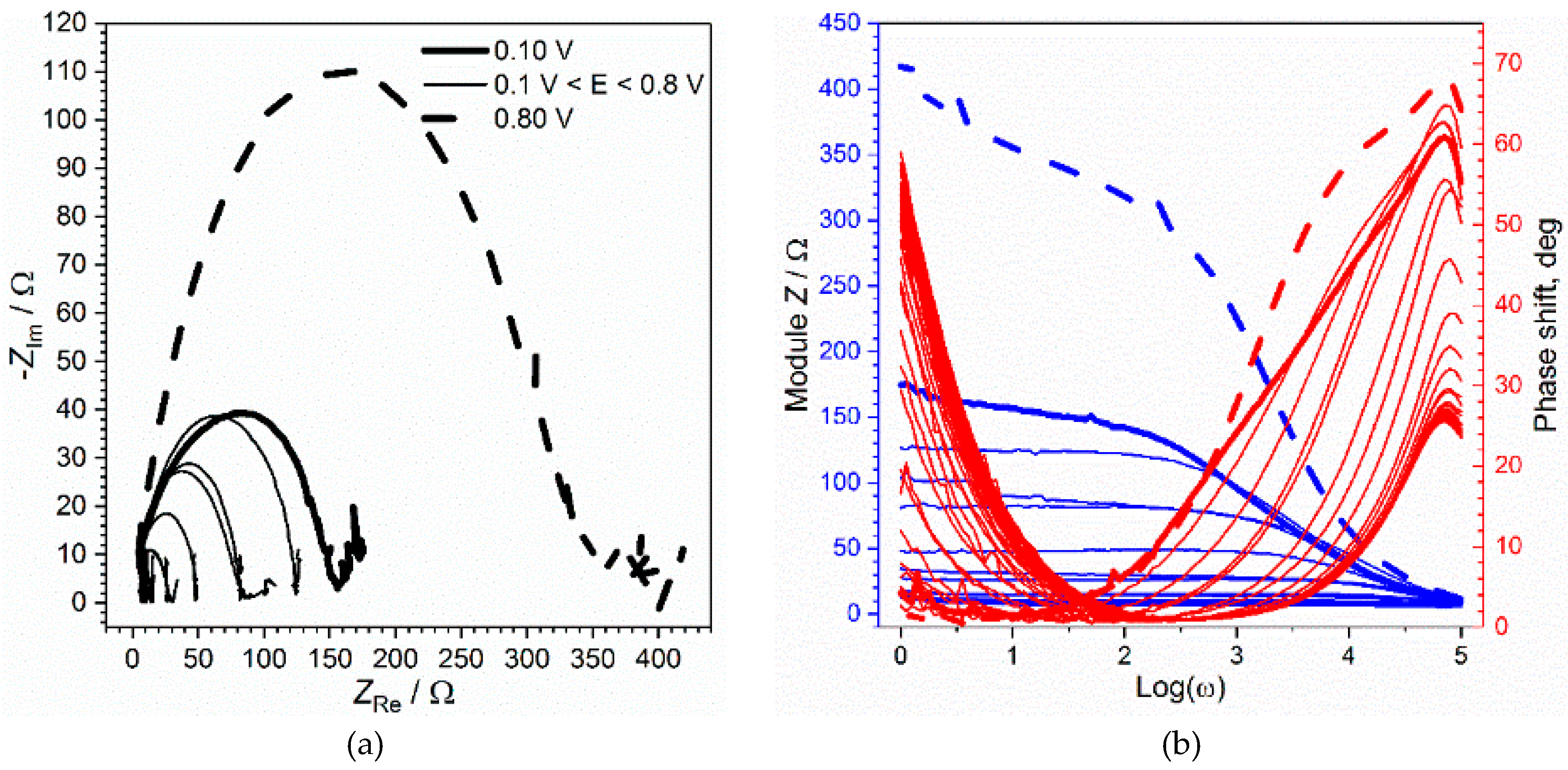
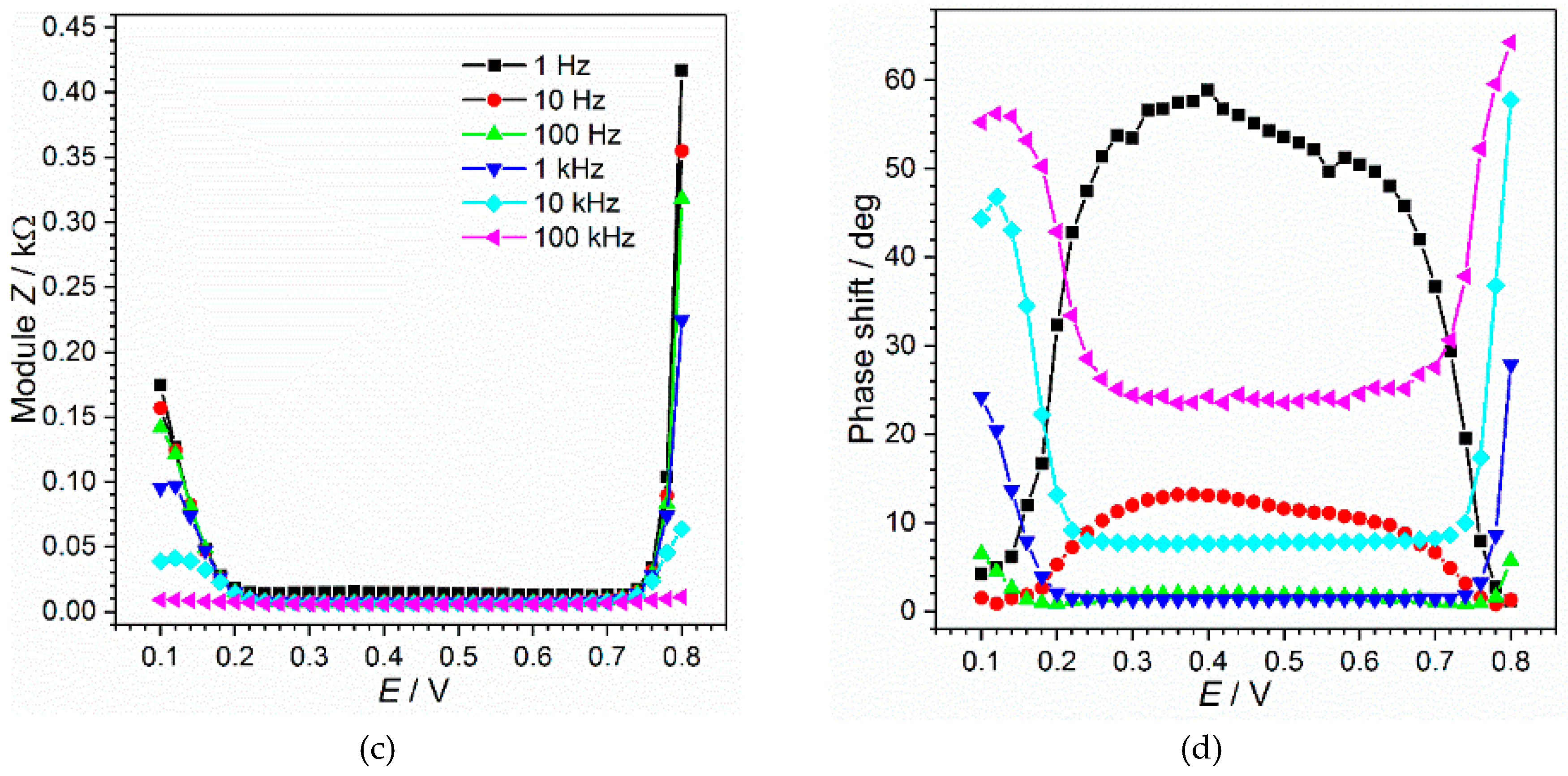
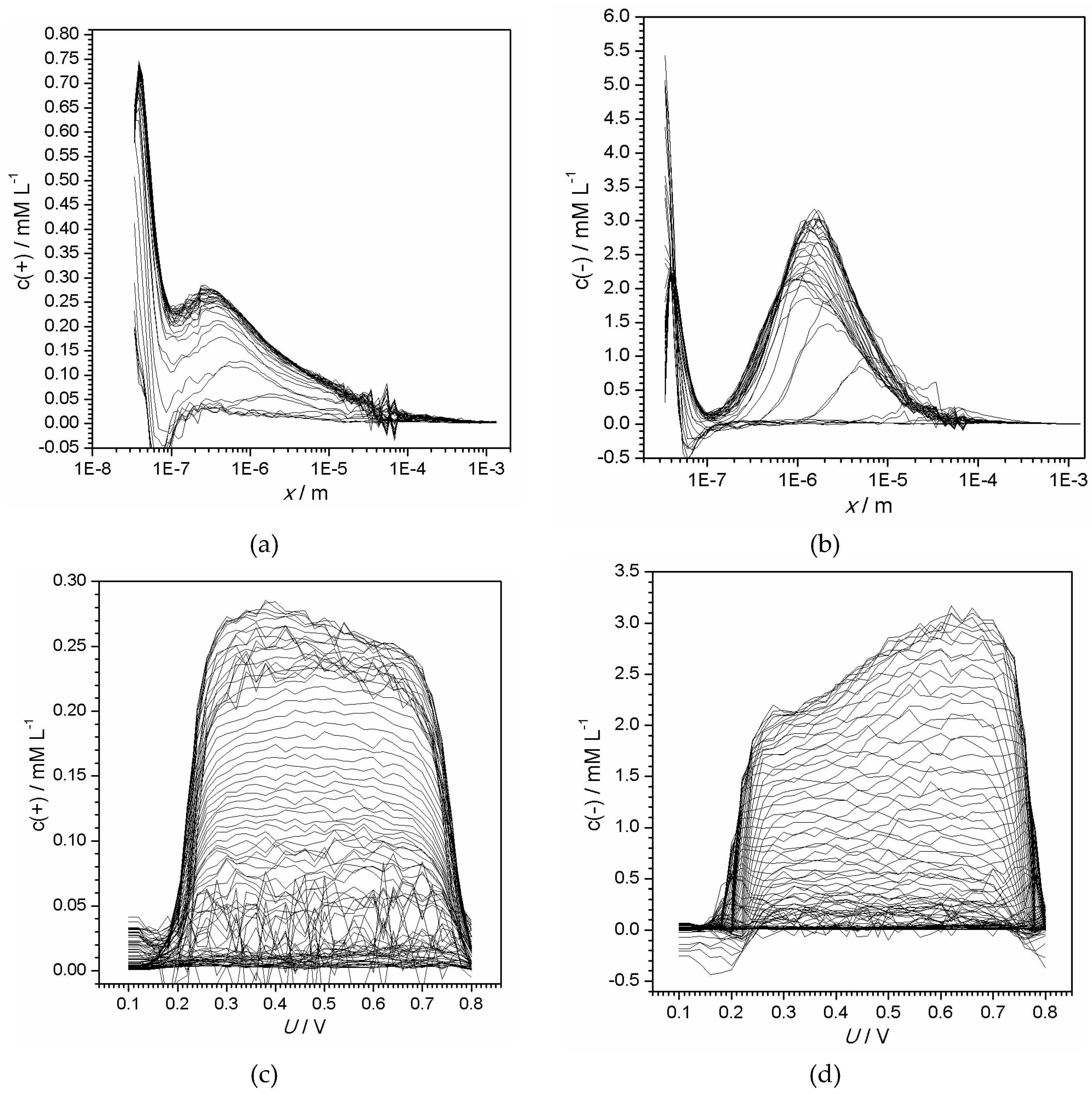
References
- Inzelt, G. Conducting Polymers; Scholz, F., Ed.; Springer: Berlin/Heidelberg, Germany, 2008. [Google Scholar]
- Skotheim, T.A.; Reynolds, J.R. Handbook of Conducting Polymers: Conjugated Polymers Processing and Applications; CRC Press: Boca Raton, FL, USA, 2007; ISBN 9781420043587. [Google Scholar]
- Lyons, M.E.G. Electroactive Polymer Electrochemistry: Part 1: Fundamentals; Springer: New York, NY, USA, 1994; ISBN 9781475750706. [Google Scholar]
- Letheby, H. XXIX.—On the production of a blue substance by the electrolysis of sulphate of aniline. J. Chem. Soc. 1862, 15, 161–163. [Google Scholar] [CrossRef]
- Geniès, E.M.; Boyle, A.; Lapkowski, M.; Tsintavis, C. Polyaniline: A historical survey. Synth. Met. 1990, 36, 139–182. [Google Scholar] [CrossRef]
- Genies, E.M.; Syed, A.A.; Tsintavis, C. Electrochemical study of polyaniline in aqueous and organic medium. Redox and kinetic properties. Mol. Cryst. Liq. Cryst. 1985, 121, 181–186. [Google Scholar] [CrossRef]
- Geniès, E.M.; Lapkowski, M.; Penneau, J.F. Cyclic voltammetry of polyaniline: Interpretation of the middle peak. J. Electroanal. Chem. Interfacial Electrochem. 1988, 249, 97–107. [Google Scholar] [CrossRef]
- Łapkowski, M.; Vieil, E. Control of polyaniline electroactivity by ion size exclusion. Synth. Met. 2000, 109, 199–201. [Google Scholar] [CrossRef]
- Genies, E.M.; Lapkowski, M. Spectroelectrochemical study of polyaniline versus potential in the equilibrium state. J. Electroanal. Chem. Interfacial Electrochem. 1987, 220, 67–82. [Google Scholar] [CrossRef]
- Lapkowski, M.; Berrada, K.; Quillard, S.; Louarn, G.; Lefrant, S.; Pron, A. Electrochemical oxidation of polyaniline in nonaqueous electrolytes: “In situ” raman spectroscopic studies. Macromolecules 1995, 28, 1233–1238. [Google Scholar] [CrossRef]
- Genies, E.M.; Lapkowski, M. Spectroelectrochemical evidence for an intermediate in the electropolymerization of aniline. J. Electroanal. Chem. Interfacial Electrochem. 1987, 236, 189–197. [Google Scholar] [CrossRef]
- Kozieł, K.; Łapkowski, M. Studies on the influence of the synthesis parameters on the doping process of polyaniline. Synth. Met. 1993, 55, 1011–1016. [Google Scholar] [CrossRef]
- Koziel, K.; Lapkowski, M.; Lefrant, S. Spectroelectrochemistry of polyaniline at low concentrations of doping anions. Synth. Met. 1995, 69, 137–138. [Google Scholar] [CrossRef]
- Kozieł, K.; Łapkowski, M. Influence of the doping anion concentration on the mechanism of redox reactions of polyaniline. Synth. Met. 1993, 55, 1005–1010. [Google Scholar] [CrossRef]
- Kozieł, K.; Łapkowski, M.; Genies, E. ESR study of polyaniline doping at various concentrations of anions. Synth. Met. 1997, 84, 105–106. [Google Scholar] [CrossRef]
- Kozieł, K.; Łapkowski, M.; Vieil, E. Microgravimetric and laser beam deflection studies of redox reactions in polyaniline at various concentrations of doping anions. Synth. Met. 1997, 84, 91–92. [Google Scholar] [CrossRef]
- Genies, E.M.; Lapkowski, M. Electrochemical in situ epr evidence of two polaron-bipolaron states in polyaniline. J. Electroanal. Chem. Interfacial Electrochem. 1987, 236, 199–208. [Google Scholar] [CrossRef]
- Lapkowski, M.; Geniés, E.M. Evidence of two kinds of spin in polyaniline from in situ EPR and electrochemistry. Influence of the electrolyte composition. J. Electroanal. Chem. Interfacial Electrochem. 1990, 279, 157–168. [Google Scholar] [CrossRef]
- Quillard, S.; Louarn, G.; Buisson, J.P.; Boyer, M.; Lapkowski, M.; Pron, A.; Lefrant, S. Vibrational spectroscopic studies of the isotope effects in polyaniline. Synth. Met. 1997, 84, 805–806. [Google Scholar] [CrossRef]
- Koziel, K.; Łapkowski, M.; Lefrant, S. Spectroelectrochemical investigations of the memory effect in polyaniline. Synth. Met. 1995, 69, 217–218. [Google Scholar] [CrossRef]
- Boyle, A.; Geniès, E.M.; Lapkowski, M. Application of the electronic conducting polymers as sensors: Polyaniline in the solid state for detection of solvent vapours and polypyrrole for detection of biological ions in solutions. Synth. Met. 1989, 28, 769–774. [Google Scholar] [CrossRef]
- Genies, E.M.; Lapkowski, M.; Santier, C.; Vieil, E. Polyaniline, spectroelectrochemistry, display and battery. Synth. Met. 1987, 18, 631–636. [Google Scholar] [CrossRef]
- Barsoukov, E.; Macdonald, J.R. Impedance Spectroscopy; Wiley-Interscience: Hoboken, NJ, USA, 2005; ISBN 9780471716242. [Google Scholar]
- Ferloni, P.; Mastragostino, M.; Meneghello, L. Impedance analysis of electronically conducting polymers. Electrochim. Acta 1996, 41, 27–33. [Google Scholar] [CrossRef]
- Ates, M. Review study of electrochemical impedance spectroscopy and equivalent electrical circuits of conducting polymers on carbon surfaces. Prog. Org. Coat. 2011, 71, 1–10. [Google Scholar] [CrossRef]
- Darowicki, K.; Kawula, J. Impedance characterization of the process of polyaniline first redox transformation after aniline electropolymerization. Electrochim. Acta 2004, 49, 4829–4839. [Google Scholar] [CrossRef]
- Hong, S.Y.; Park, S.M. Electrochemistry of conductive polymers 40. Earlier phases of aniline polymerization studied by fourier transform electrochemical impedance spectroscopy. J. Phys. Chem. B 2007, 111, 9779–9786. [Google Scholar] [CrossRef] [PubMed]
- Gabrielli, C.; Haas, O.; Takenouti, H. Impedance analysis of electrodes modified with a reversible redox polymer film. J. Appl. Electrochem. 1987, 17, 82–90. [Google Scholar] [CrossRef]
- Popkirov, G.S.; Barsoukov, E.; Schindler, R.N. Investigation of conducting polymer electrodes by impedance spectroscopy during electropolymerization under galvanostatic conditions. J. Electroanal. Chem. 1997, 425, 209–216. [Google Scholar] [CrossRef]
- Darowicki, K.; Kawula, J. Dynamic electrochemical impedance spectroscopy of the adsorption and relaxation of polyaniline chains during potentiodynamic redox transformations. Russ. J. Electrochem. 2007, 43, 1055–1063. [Google Scholar] [CrossRef]
- Ulgut, B.; Grose, J.E.; Kiya, Y.; Ralph, D.C.; Abruña, H.D. A new interpretation of electrochemical impedance spectroscopy to measure accurate doping levels for conducting polymers: Separating faradaic and capacitive currents. Appl. Surf. Sci. 2009, 256, 1304–1308. [Google Scholar] [CrossRef]
- Vorotyntsev, M.; Deslouis, C.; Musiani, M. Transport across an electroactive polymer film in contact with media allowing both ionic and electronic interfacial exchange. Electrochim. Acta 1999, 44, 2105–2115. [Google Scholar] [CrossRef]
- Vorotyntsev, M.A.; Badiali, J.P.; Inzelt, G. Electrochemical impedance spectroscopy of thin films with two mobile charge carriers: Effects of the interfacial charging. J. Electroanal. Chem. 1999, 472, 7–19. [Google Scholar] [CrossRef]
- Láng, G.; Inzelt, G. An advanced model of the impedance of polymer film electrodes. Electrochim. Acta 1999, 44, 2037–2051. [Google Scholar] [CrossRef]
- Láng, G.; Ujvári, M.; Inzelt, G. Analysis of the impedance spectra of Pt|poly(o-phenylenediamine) electrodes - Hydrogen adsorption and the brush model of the polymer films. J. Electroanal. Chem. 2004, 572, 283–297. [Google Scholar] [CrossRef]
- Bisquert, J.; Belmonte, G.G.; Santiago, F.F.; Ferriols, N.S.; Yamashita, M.; Pereira, E.C. Application of a distributed impedance model in the analysis of conducting polymer films. Electrochem. Commun. 2000, 2, 601–605. [Google Scholar] [CrossRef]
- Garcia-Belmonte, G.; Fabregat-Santiago, F.; Bisquert, J.; Yamashita, M.; Pereira, E.C.; Castro-Garcia, S. Frequency dispersion in electrochromic devices and conducting polymer electrodes: A generalized transmission line approach. Int. J. Ion. Sci. Technol. Ion. Motion 1999, 5, 44–51. [Google Scholar] [CrossRef]
- Ragoisha, G.A.; Bondarenko, A.S. Potentiodynamic electrochemical impedance spectroscopy. Electrochim. Acta 2005, 50, 1553–1563. [Google Scholar] [CrossRef]
- Lasia, A. Electrochemical Impedance Spectroscopy and its Applications; Springer-Verlag: New York, NY, USA, 2014; ISBN 978-1-4614-8932-0. [Google Scholar]
- Vladikova, D.; Stoynov, Z.; Viviani, M. Application of the differential impedance analysis for investigation of electroceramics. J. Eur. Ceram. Soc. 2004, 24, 1121–1127. [Google Scholar] [CrossRef]
- Vladikova, D.; Stoynov, Z. Secondary differential impedance analysis - A tool for recognition of CPE behavior. J. Electroanal. Chem. 2004, 572, 377–387. [Google Scholar] [CrossRef]
- Vladikova, D. Selectivity study of the differential impedance analysis—Comparison with the complex non-linear least-squares method. Electrochim. Acta 2002, 47, 2943–2951. [Google Scholar] [CrossRef]
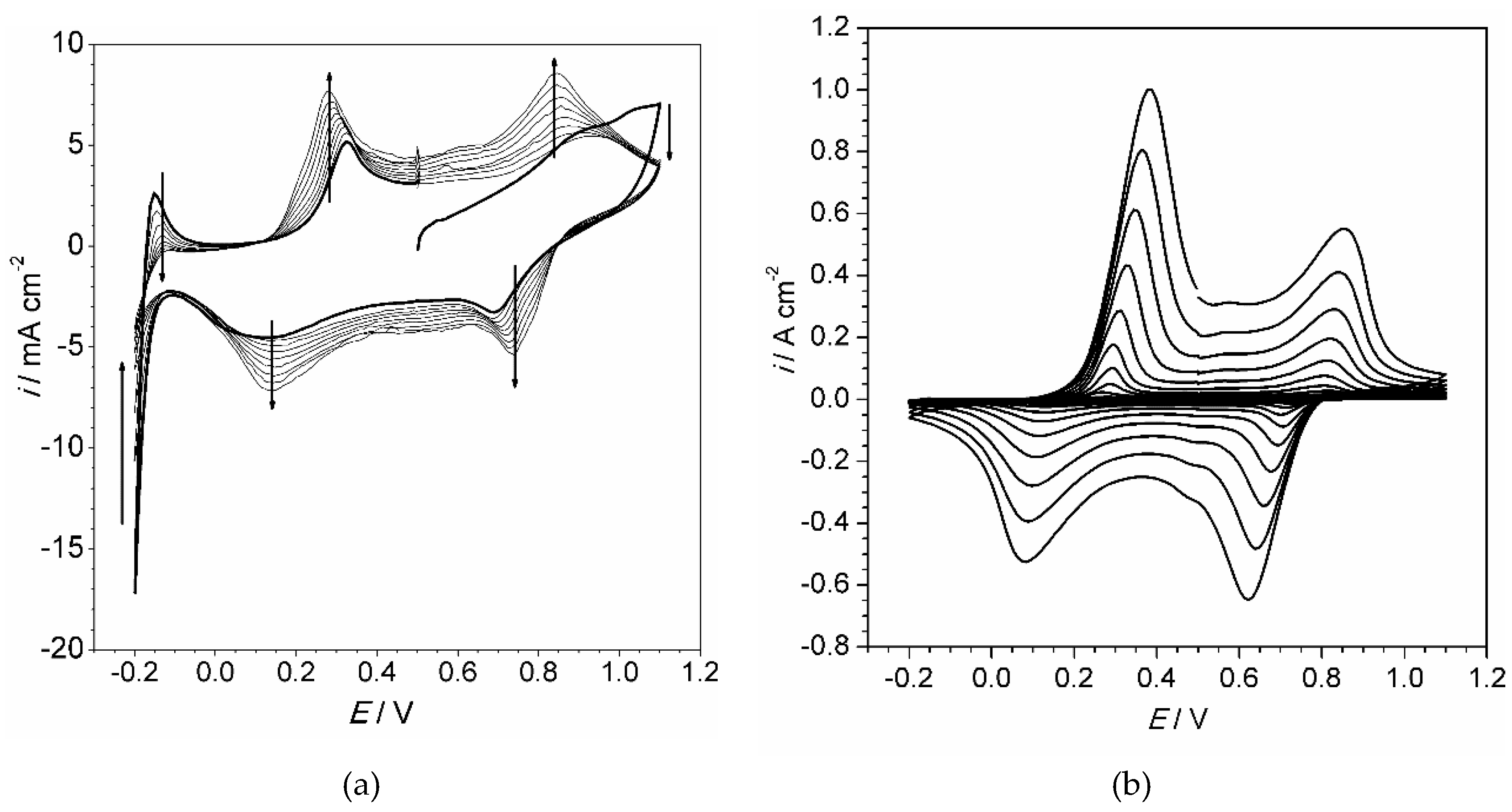
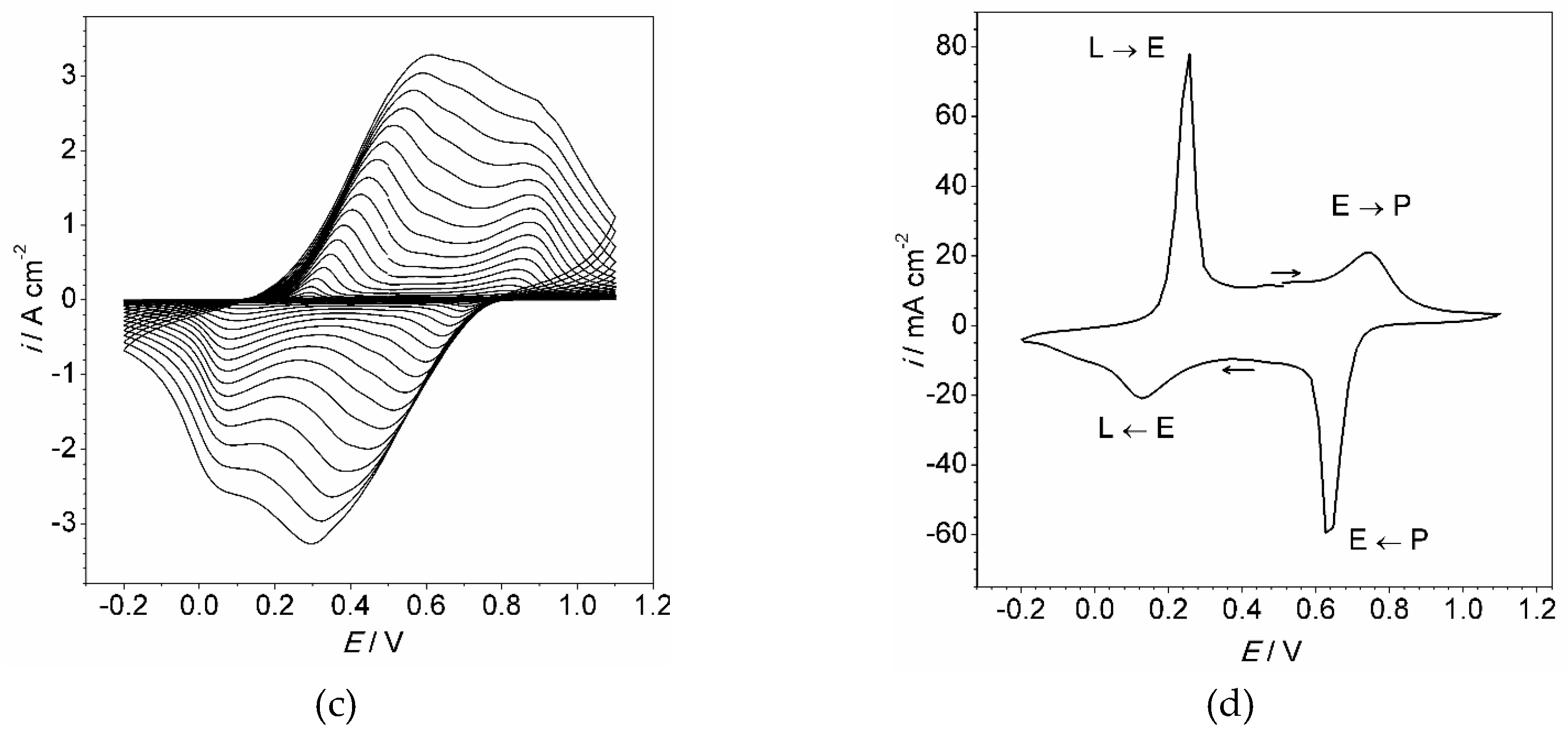
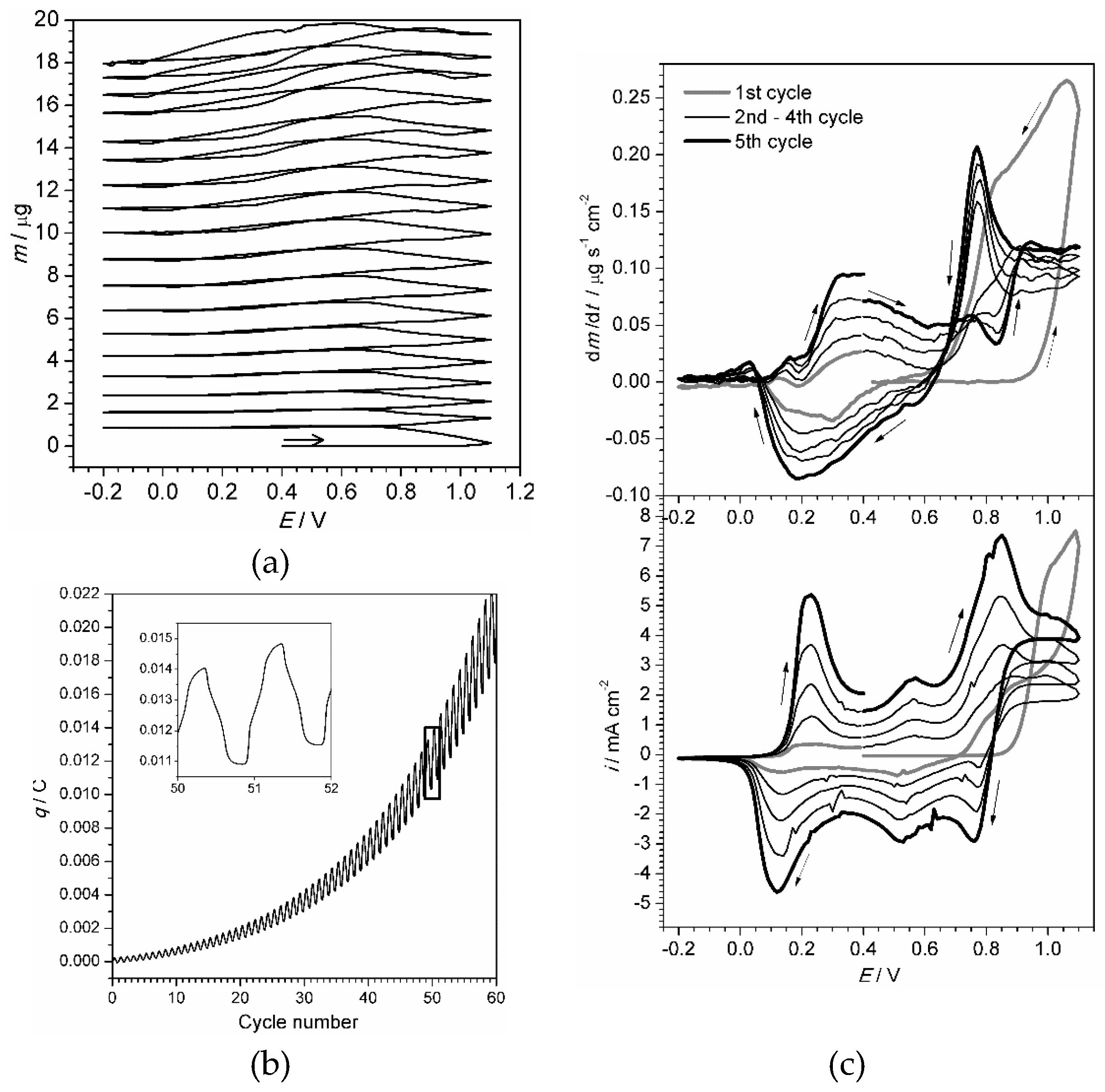
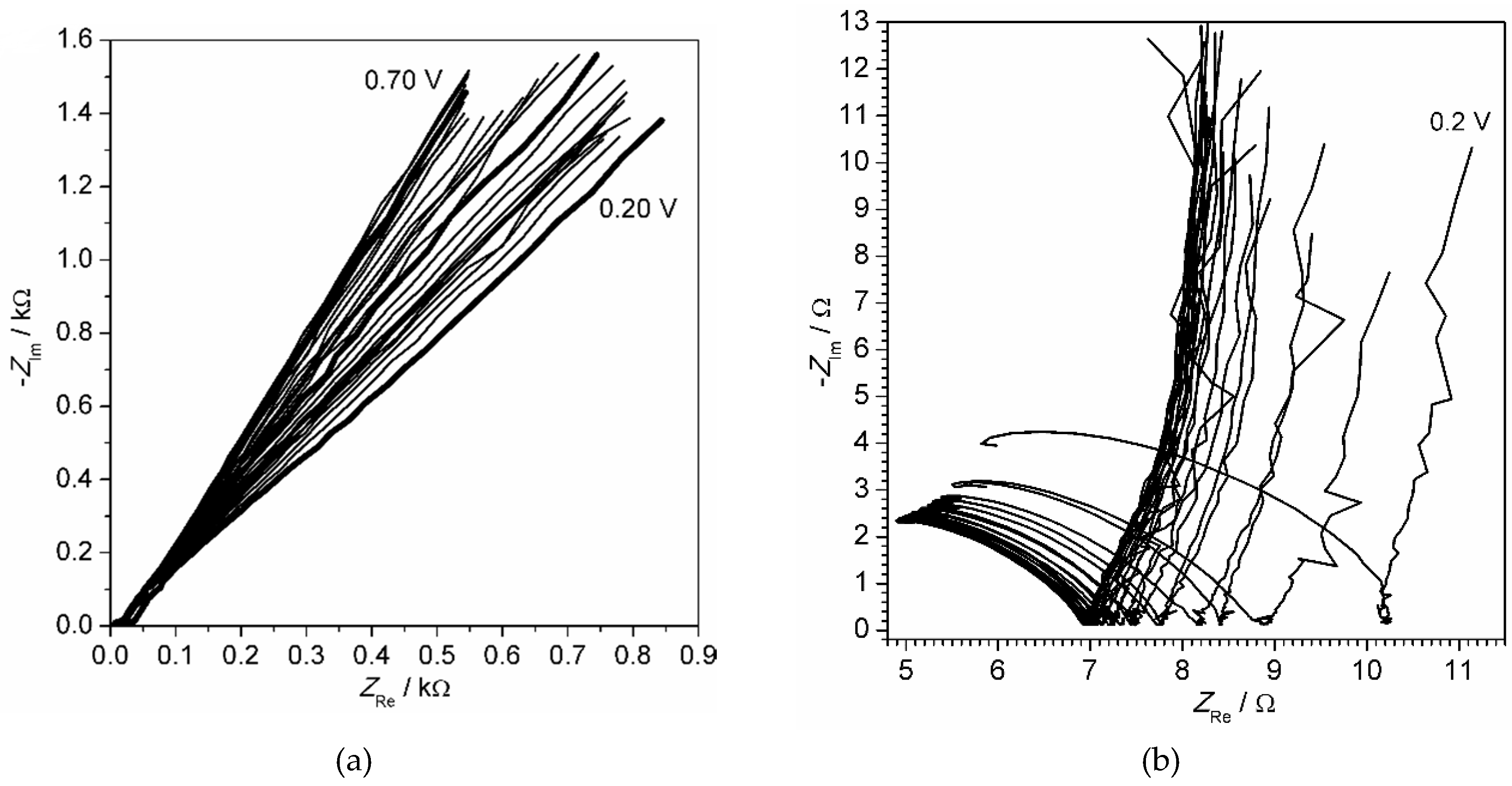
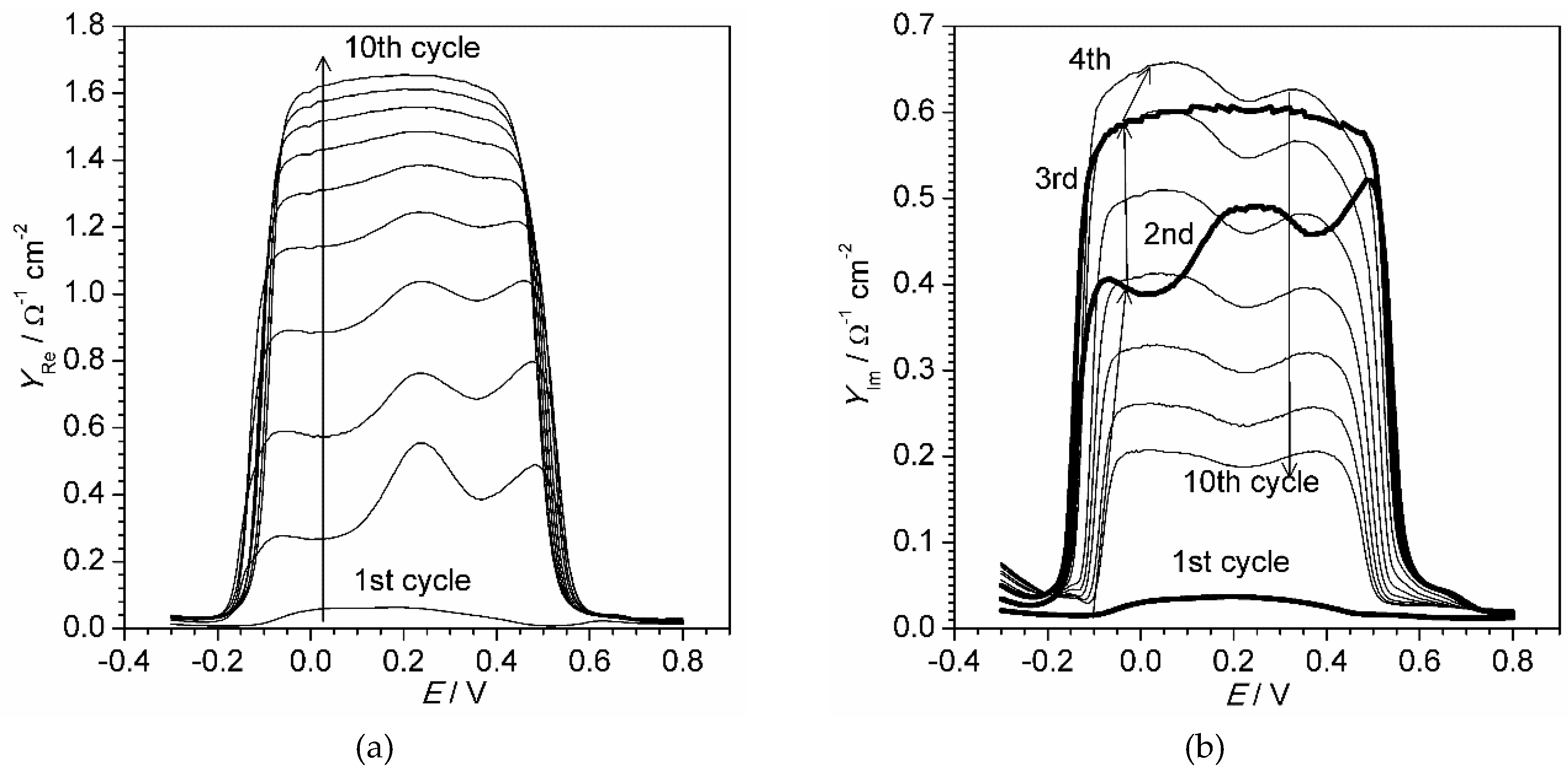
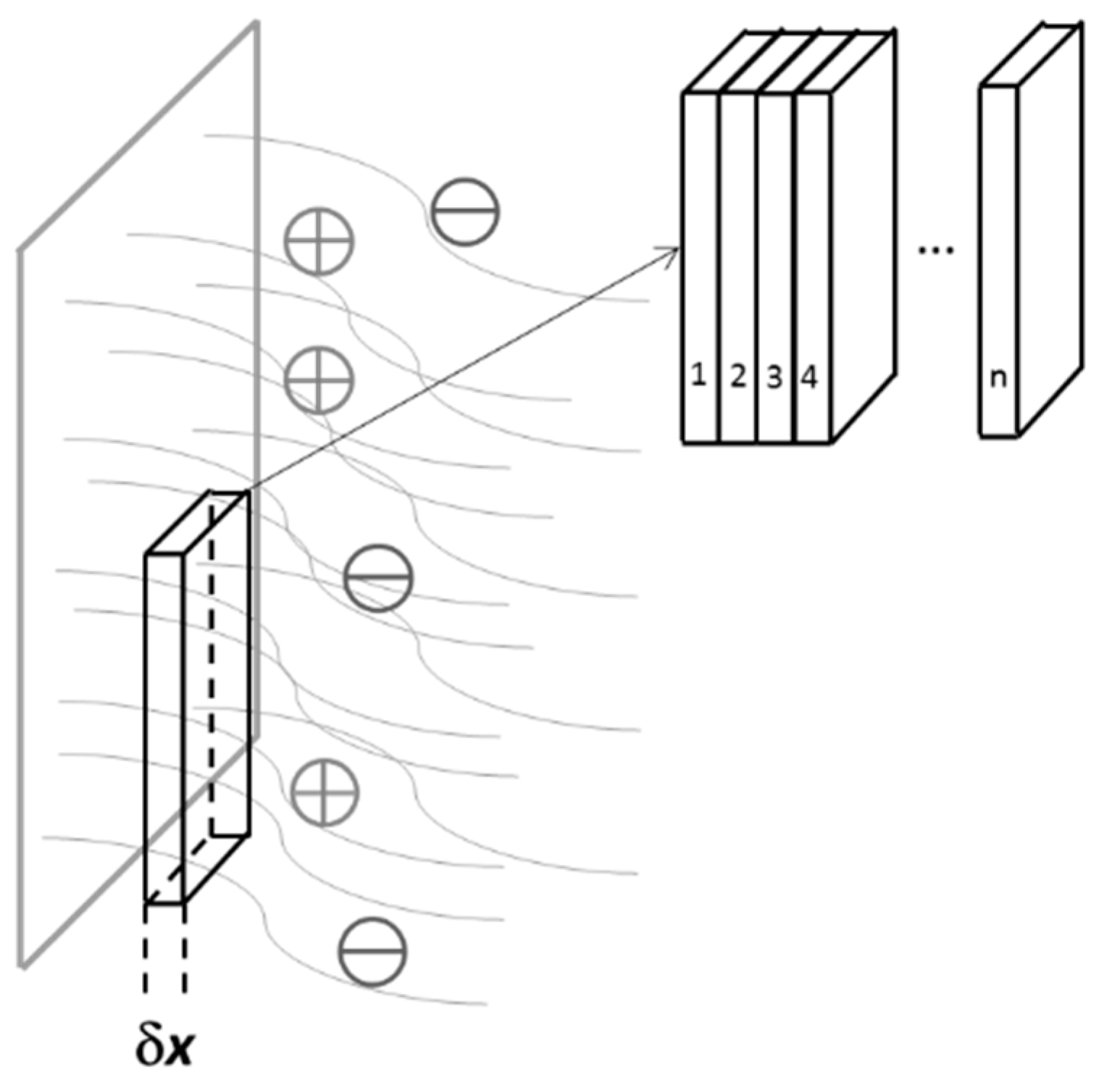
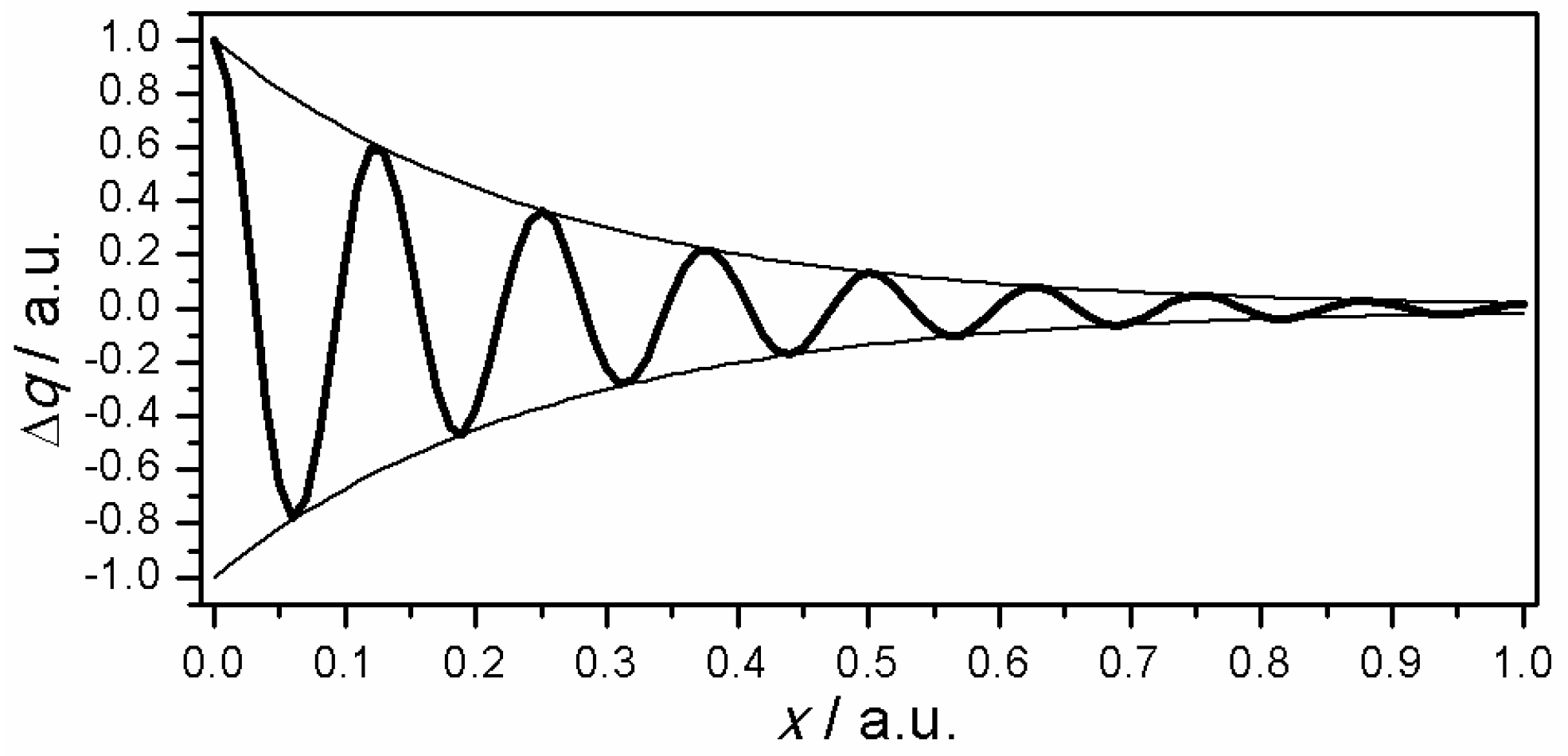
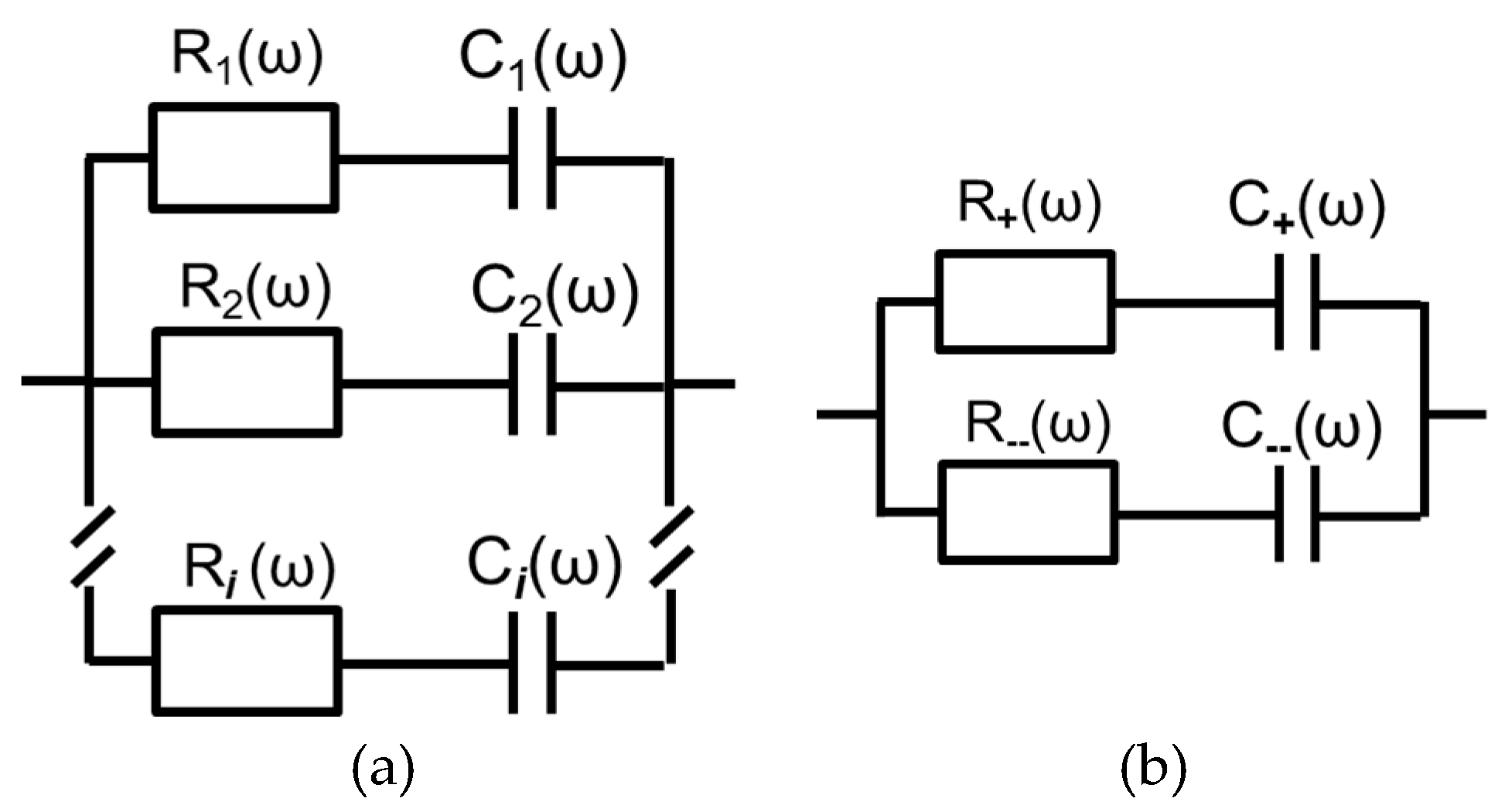
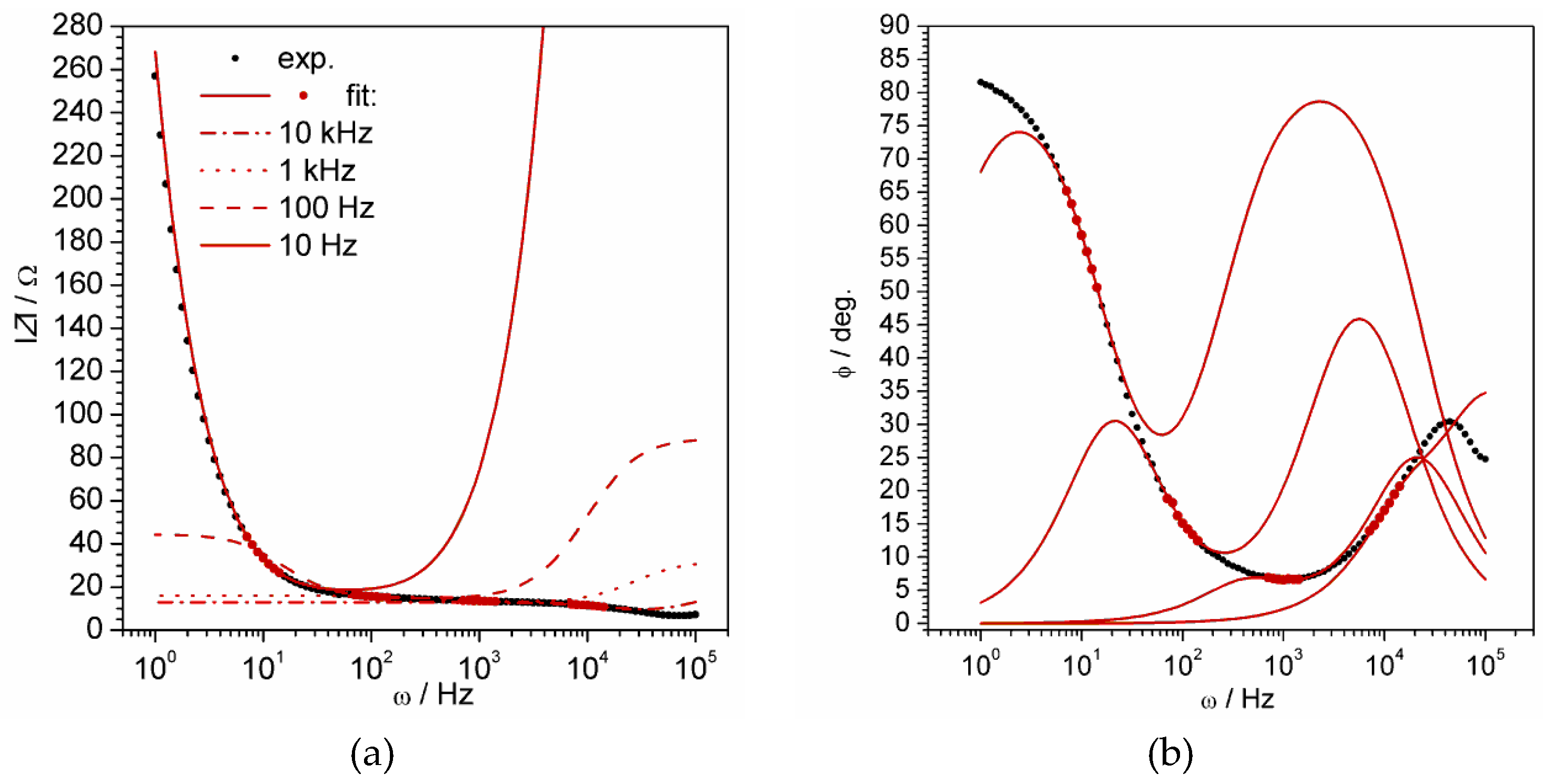
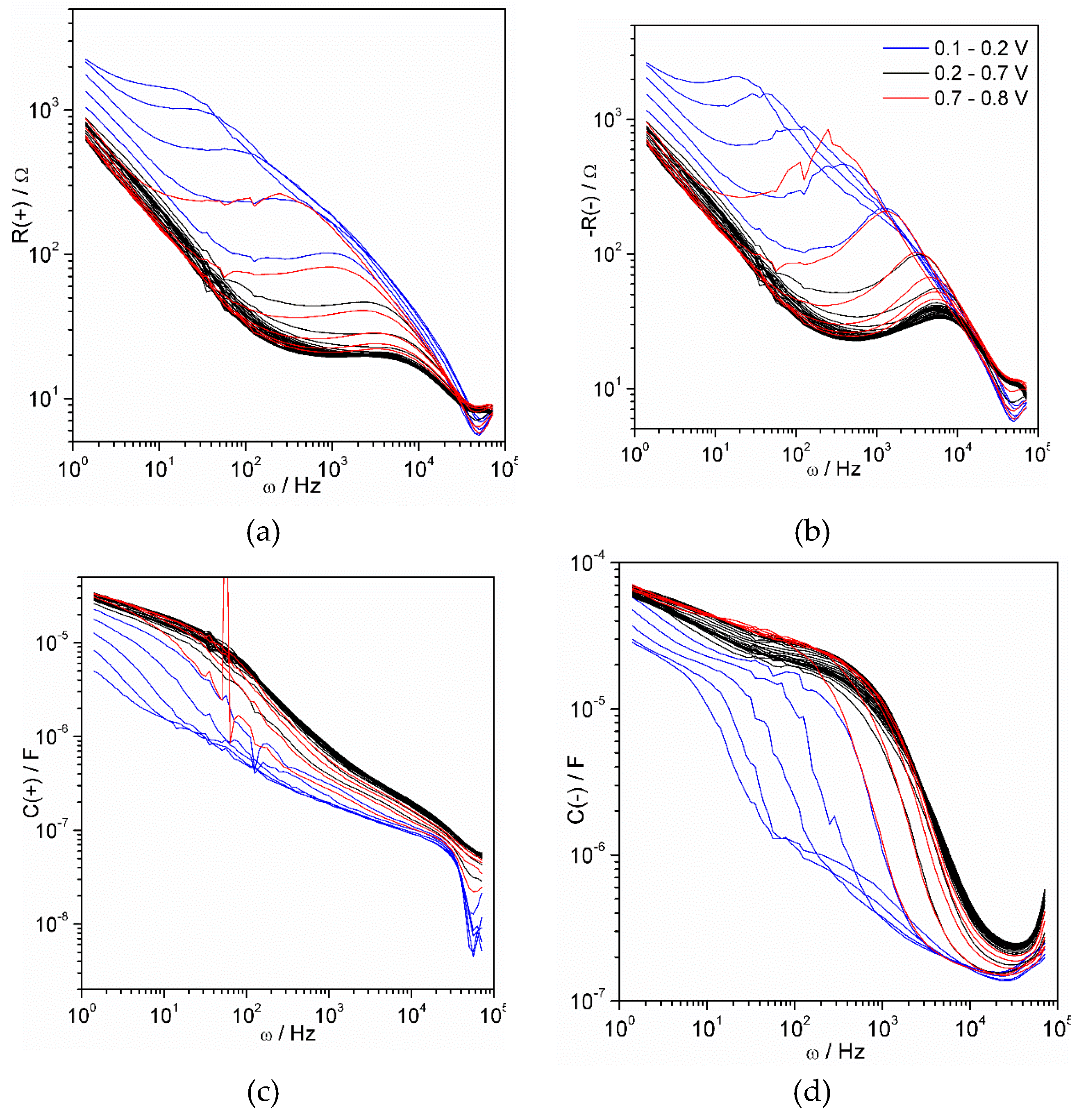
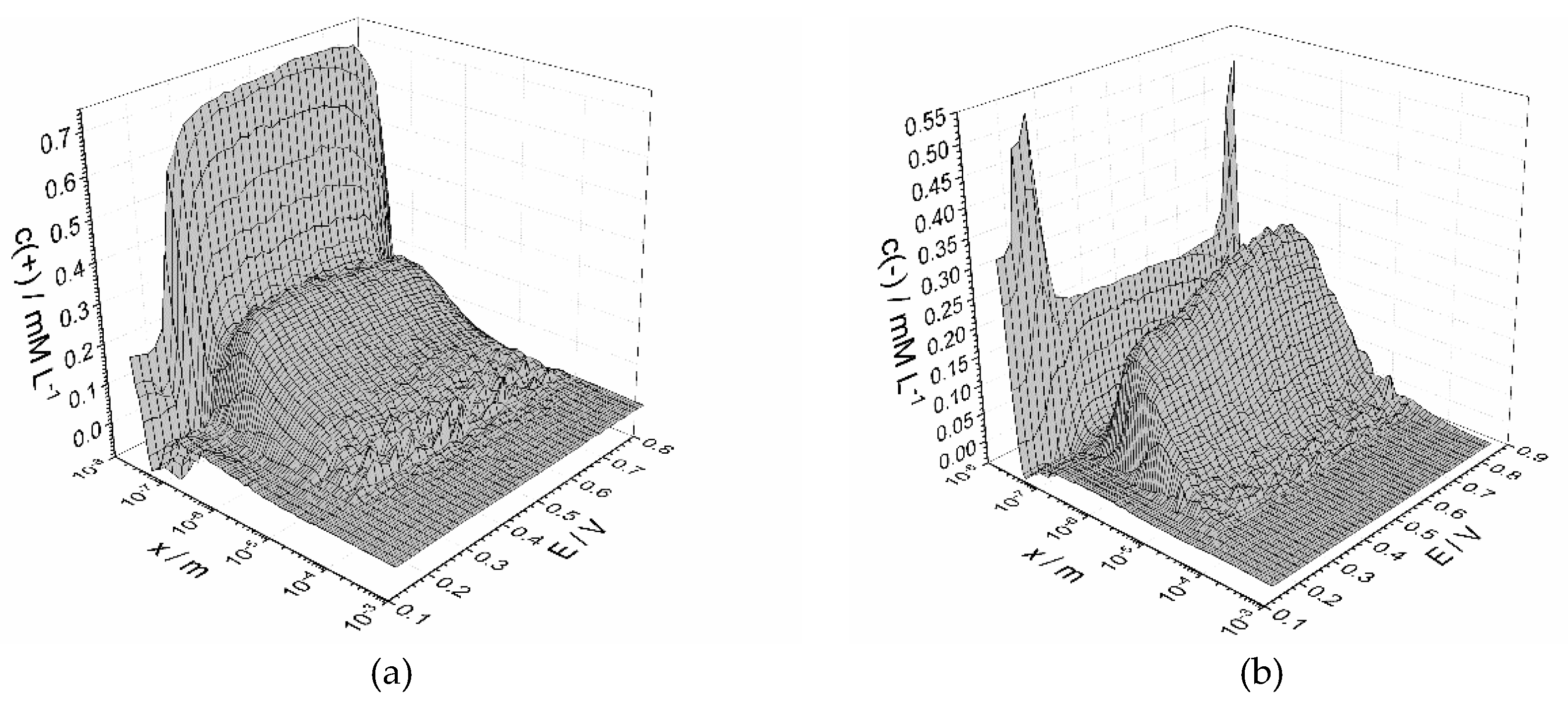
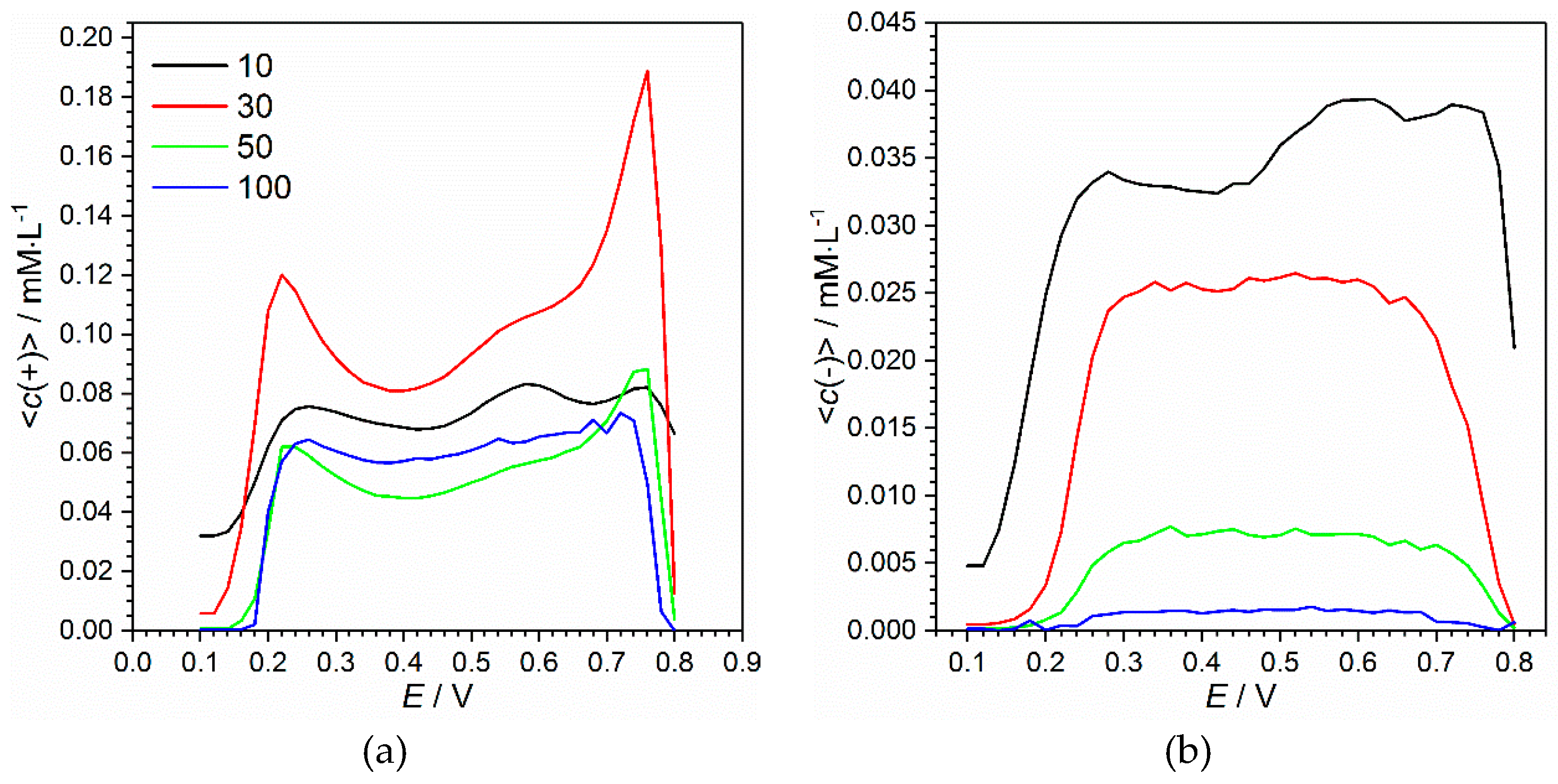
| Cycle Number | Charge Consumed for Electropolymerization/C | Estimated Thickness/m |
|---|---|---|
| 10 | 4.212 × 10−4 | 2.6 × 10−7 |
| 30 | 3.030 × 10−3 | 1.9 × 10−6 |
| 50 | 1.036 × 10−2 | 6.4 × 10−6 |
| 100 | 1.034 × 10−2 | 6.4 × 10−5 |
© 2020 by the authors. Licensee MDPI, Basel, Switzerland. This article is an open access article distributed under the terms and conditions of the Creative Commons Attribution (CC BY) license (http://creativecommons.org/licenses/by/4.0/).
Share and Cite
Chulkin, P.; Łapkowski, M. An Insight into Ionic Conductivity of Polyaniline Thin Films. Materials 2020, 13, 2877. https://doi.org/10.3390/ma13122877
Chulkin P, Łapkowski M. An Insight into Ionic Conductivity of Polyaniline Thin Films. Materials. 2020; 13(12):2877. https://doi.org/10.3390/ma13122877
Chicago/Turabian StyleChulkin, Pavel, and Mieczysław Łapkowski. 2020. "An Insight into Ionic Conductivity of Polyaniline Thin Films" Materials 13, no. 12: 2877. https://doi.org/10.3390/ma13122877
APA StyleChulkin, P., & Łapkowski, M. (2020). An Insight into Ionic Conductivity of Polyaniline Thin Films. Materials, 13(12), 2877. https://doi.org/10.3390/ma13122877





